
Genre 101 looks at the past and present of a game genre to find lessons about what defines it. In this installment, Graham Russell brings in Andrew Passafiume to discuss the key elements of the third-person shooter.

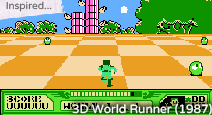
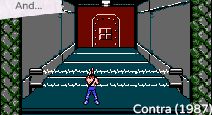
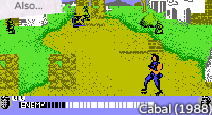
You’re right behind you
 Andrew Passafiume: To me, Space Harrier is the first true third-person shooter. It features a behind-the-back perspective and, unlike similar titles, was character-focused; those are the basics you would expect from any modern third-person shooter. It even inspired titles like Contra, which, despite primarily being a side-scroller, featured levels designed in a traditional third-person shooter perspective.
Andrew Passafiume: To me, Space Harrier is the first true third-person shooter. It features a behind-the-back perspective and, unlike similar titles, was character-focused; those are the basics you would expect from any modern third-person shooter. It even inspired titles like Contra, which, despite primarily being a side-scroller, featured levels designed in a traditional third-person shooter perspective.
 Graham Russell: It began this process of partial abstraction. First-person shooters make sense from a perspective, um, perspective: you see what the character sees. Top-down or side-scrolling games don’t even pretend. Third-person games, though, try to use the view to allow use of your real-world aiming abilities, but it’s a half-measure that is surprising in its usefulness.
Graham Russell: It began this process of partial abstraction. First-person shooters make sense from a perspective, um, perspective: you see what the character sees. Top-down or side-scrolling games don’t even pretend. Third-person games, though, try to use the view to allow use of your real-world aiming abilities, but it’s a half-measure that is surprising in its usefulness.
 Truthfully, most games from this era were third-person simply because you could see what you were controlling as you were controlling it, even if it wasn’t “behind-the-back” necessarily. However, they never attempted a successful half-step between the traditional and the soon-to-come (first-person shooters). Space Harrier simply gave the player a perspective that made sense for a game where you controlled an actual character while also allowing for the game’s main selling point, the shooting, to feel more prominent than in other, similar titles.
Truthfully, most games from this era were third-person simply because you could see what you were controlling as you were controlling it, even if it wasn’t “behind-the-back” necessarily. However, they never attempted a successful half-step between the traditional and the soon-to-come (first-person shooters). Space Harrier simply gave the player a perspective that made sense for a game where you controlled an actual character while also allowing for the game’s main selling point, the shooting, to feel more prominent than in other, similar titles.

Glimpses of a new era
 Let’s fast-forward ten years, to the era when 3D games were becoming the next big thing. Fade to Black, the sequel to the cult-classic Flashback, was the first 3D action game that plays like a traditional third-person shooter. It’s responsible for taking the Space Harrier concept and evolving it beyond its rail-shooter roots. When people think of traditional third-person shooters, games like Fade to Black come to mind more than any title prior to its release.
Let’s fast-forward ten years, to the era when 3D games were becoming the next big thing. Fade to Black, the sequel to the cult-classic Flashback, was the first 3D action game that plays like a traditional third-person shooter. It’s responsible for taking the Space Harrier concept and evolving it beyond its rail-shooter roots. When people think of traditional third-person shooters, games like Fade to Black come to mind more than any title prior to its release.
 A sequel is rarely a genre-creating sort of release, but Fade to Black manages to make that happen. Do you think there was something Delphine Software wanted to do, or some part of the story it wanted to tell, that spawned this sort of innovation?
A sequel is rarely a genre-creating sort of release, but Fade to Black manages to make that happen. Do you think there was something Delphine Software wanted to do, or some part of the story it wanted to tell, that spawned this sort of innovation?
 It seemed like the end goal was simply to make a sequel to Flashback that met the standards people expected from games at the time. It was only natural to make it a 3D shooter, allowing for a modern take on an existing idea. Everything that followed, including the evolution of an entire genre that, at the time, barely existed in the first place, seemed almost coincidental. That’s not an attempt to belittle Fade to Black’s triumphs, but with games like Tomb Raider on the horizon, it seemed to come out at just the right time in order to achieve the success it needed to be a landmark title.
It seemed like the end goal was simply to make a sequel to Flashback that met the standards people expected from games at the time. It was only natural to make it a 3D shooter, allowing for a modern take on an existing idea. Everything that followed, including the evolution of an entire genre that, at the time, barely existed in the first place, seemed almost coincidental. That’s not an attempt to belittle Fade to Black’s triumphs, but with games like Tomb Raider on the horizon, it seemed to come out at just the right time in order to achieve the success it needed to be a landmark title.
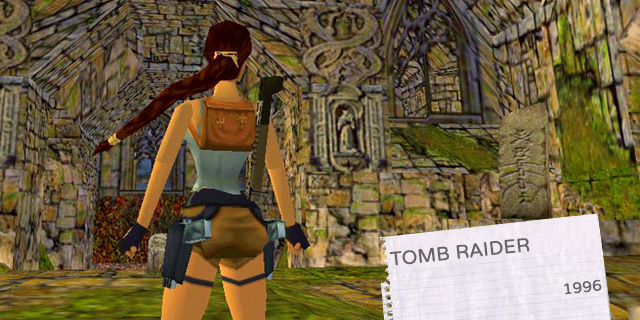
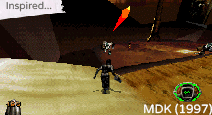


First action hero
 If Fade to Black started the 3D third-person shooter trend, Tomb Raider revolutionized it. Not only did it popularize the genre and make way for a whole slew of similar titles, it managed to add more to this style of shooter than previous releases did. It wasn’t just a shooter; it was also about platforming and puzzle-solving. If the origins of the genre focused entirely (or mostly) on the shooting part of a third-person shooter, Tomb Raider focused on how to conceptually evolve it above all else.
If Fade to Black started the 3D third-person shooter trend, Tomb Raider revolutionized it. Not only did it popularize the genre and make way for a whole slew of similar titles, it managed to add more to this style of shooter than previous releases did. It wasn’t just a shooter; it was also about platforming and puzzle-solving. If the origins of the genre focused entirely (or mostly) on the shooting part of a third-person shooter, Tomb Raider focused on how to conceptually evolve it above all else.
 It was this platforming aspect that made it work better with a zoomed-out camera; to this day, you can’t really rely on your footing in a first-person game. But it’s still appealing to the wide Western audience that we know well now and that’s key to overwhelming success and profit.
It was this platforming aspect that made it work better with a zoomed-out camera; to this day, you can’t really rely on your footing in a first-person game. But it’s still appealing to the wide Western audience that we know well now and that’s key to overwhelming success and profit.
 Exactly. You simply can’t have that level of character control in a first-person game no matter how hard you try. Tomb Raider really proved the importance and necessity of the third-person shooter simply by offering you more control over your character. It may seem trivial now, but back then, it was enough to better establish the differences between two otherwise-similar genres.
Exactly. You simply can’t have that level of character control in a first-person game no matter how hard you try. Tomb Raider really proved the importance and necessity of the third-person shooter simply by offering you more control over your character. It may seem trivial now, but back then, it was enough to better establish the differences between two otherwise-similar genres.




Got you covered
 If there’s one singular third-person shooter mechanic that has been utilized and changed over time more than any other, it’s the cover system. While WinBack may not be fondly remembered, it is the first that instituted a cover system, a staple of the genre. The ability to hide behind walls or other barriers is such a straightforward concept, yet it never found its place in the third-person shooter until now.
If there’s one singular third-person shooter mechanic that has been utilized and changed over time more than any other, it’s the cover system. While WinBack may not be fondly remembered, it is the first that instituted a cover system, a staple of the genre. The ability to hide behind walls or other barriers is such a straightforward concept, yet it never found its place in the third-person shooter until now.
 That positioning is key to third-person shooters, for sure. It’s worth noting that, generally, most of the first games to try a thing don’t do that thing very well. Occasionally they’ll be popular anyway, or on the merits of the rest of the package, but most of the time the pioneers deal with an unfortunate reception. But without them, the better games wouldn’t follow.
That positioning is key to third-person shooters, for sure. It’s worth noting that, generally, most of the first games to try a thing don’t do that thing very well. Occasionally they’ll be popular anyway, or on the merits of the rest of the package, but most of the time the pioneers deal with an unfortunate reception. But without them, the better games wouldn’t follow.
 WinBack is a game most people tend to forget about simply because it wasn’t particularly groundbreaking in most ways, but it did one thing that ultimately allowed the genre to evolve in a way that made sense. It might not belong on a list of the all-time greats, but there’s no denying how one mechanic changed so much in the coming years.
WinBack is a game most people tend to forget about simply because it wasn’t particularly groundbreaking in most ways, but it did one thing that ultimately allowed the genre to evolve in a way that made sense. It might not belong on a list of the all-time greats, but there’s no denying how one mechanic changed so much in the coming years.
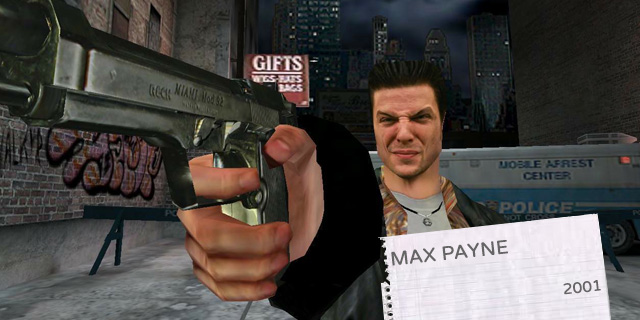



Bullet-time, all the time
 Besides focusing on puzzles and platforming, Tomb Raider gave players the ability to jump around while shooting. It’s a little silly, sure, but the added mobility gave people something new. Max Payne took that concept and ran with it, not only focusing on mobility while shooting, but also on “bullet-time,” allowing you to slow down time while shooting for increased accuracy. Suffice to say, it started a huge trend we saw in many shooters, both first and third, since. It’s also one of the first games that relied on player-controlled aiming, forcing you to not rely on auto-aim, making the bullet time mechanic even more essential to survival.
Besides focusing on puzzles and platforming, Tomb Raider gave players the ability to jump around while shooting. It’s a little silly, sure, but the added mobility gave people something new. Max Payne took that concept and ran with it, not only focusing on mobility while shooting, but also on “bullet-time,” allowing you to slow down time while shooting for increased accuracy. Suffice to say, it started a huge trend we saw in many shooters, both first and third, since. It’s also one of the first games that relied on player-controlled aiming, forcing you to not rely on auto-aim, making the bullet time mechanic even more essential to survival.
 It’s the combination of shooting and acrobatics that makes the third-person game an ideal fit for your super-spies and action heroes. You’re capable of doing so much that is needed to tell these tales. So adding in movie mechanics like bullet-time just seems natural.
It’s the combination of shooting and acrobatics that makes the third-person game an ideal fit for your super-spies and action heroes. You’re capable of doing so much that is needed to tell these tales. So adding in movie mechanics like bullet-time just seems natural.
 Not only is it a natural fit, it allows the genre to expand beyond the focus on shooting. These games are third-person shooters, so it will always be a dominant aspect, but titles like this and Tomb Raider demonstrate immediate variety by simply allowing for more control. It’s a problem most first-person shooters tend to run into and, at times, can’t escape from.
Not only is it a natural fit, it allows the genre to expand beyond the focus on shooting. These games are third-person shooters, so it will always be a dominant aspect, but titles like this and Tomb Raider demonstrate immediate variety by simply allowing for more control. It’s a problem most first-person shooters tend to run into and, at times, can’t escape from.
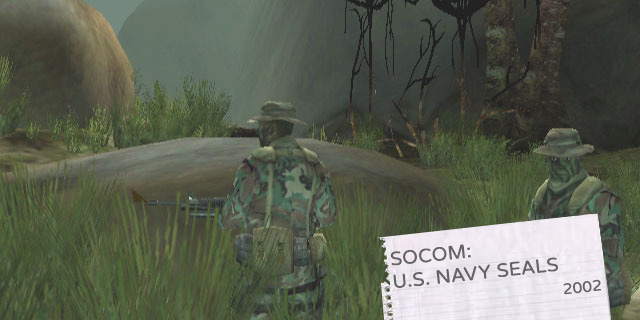

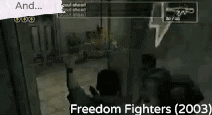

Knowing what’s around you
 Most third-person shooters of this era, like Max Payne, focused on over-the-top action and crazy shootouts. SOCOM is the first tactical third-person shooter that boiled the gameplay down to the essentials: kill or be killed. It’s a game all about teamwork and strategy, making sure you are on the top of your game at all times and punishing you for any missteps. Unlike similar first-person games, the third-person perspective made it easier to see your surroundings, including both your teammates and your targets. This was essential in the game’s multiplayer as well; SOCOM was one of the first console shooters to feature online play, which became a huge selling point for the series and other titles like it.
Most third-person shooters of this era, like Max Payne, focused on over-the-top action and crazy shootouts. SOCOM is the first tactical third-person shooter that boiled the gameplay down to the essentials: kill or be killed. It’s a game all about teamwork and strategy, making sure you are on the top of your game at all times and punishing you for any missteps. Unlike similar first-person games, the third-person perspective made it easier to see your surroundings, including both your teammates and your targets. This was essential in the game’s multiplayer as well; SOCOM was one of the first console shooters to feature online play, which became a huge selling point for the series and other titles like it.
 There are tactical elements to first-person shooters, too, though. What is it about SOCOM’s third-person trappings that makes it work better or do more? In the same way, what does it do better than squad-based military strategy games with top-down perspectives?
There are tactical elements to first-person shooters, too, though. What is it about SOCOM’s third-person trappings that makes it work better or do more? In the same way, what does it do better than squad-based military strategy games with top-down perspectives?
 It’s all about perspective. When you have a game that involves working with others, either AI or humans, having a better sense of where you are relative to them at any time, regardless of where you are looking, is important when you need to make tactical decisions. The large, open maps and ruthless difficulty took full advantage of this perspective and made sure you were aware of your surroundings at all time. As for strategy games, simply having that direct control is enough to, for example, differentiate a SOCOM multiplayer match from any multiplayer strategy game. Tactics are important, but there’s also that immediate action needed when you are taking down an opponent that you simply don’t get from strategy titles. SOCOM became a seamless blend of two ideas, and succeeded as a result.
It’s all about perspective. When you have a game that involves working with others, either AI or humans, having a better sense of where you are relative to them at any time, regardless of where you are looking, is important when you need to make tactical decisions. The large, open maps and ruthless difficulty took full advantage of this perspective and made sure you were aware of your surroundings at all time. As for strategy games, simply having that direct control is enough to, for example, differentiate a SOCOM multiplayer match from any multiplayer strategy game. Tactics are important, but there’s also that immediate action needed when you are taking down an opponent that you simply don’t get from strategy titles. SOCOM became a seamless blend of two ideas, and succeeded as a result.
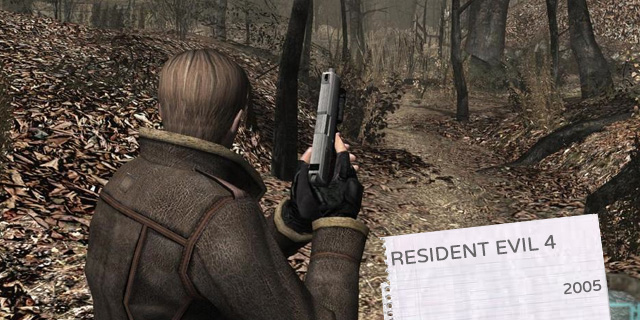



Something over your shoulder
 Some people might argue that Resident Evil 4 is a survival-horror game first, action game second, but that doesn’t lessen its impact on the third-person shooter genre. Its use of over-the-shoulder offset camera angles quickly became a predominant feature, allowing for a less obscured look at what’s in front of you and improving accuracy in the process. It speaks to the major differences between first and third-person shooters when a seemingly minor camera change does enough to evolve an entire genre.
Some people might argue that Resident Evil 4 is a survival-horror game first, action game second, but that doesn’t lessen its impact on the third-person shooter genre. Its use of over-the-shoulder offset camera angles quickly became a predominant feature, allowing for a less obscured look at what’s in front of you and improving accuracy in the process. It speaks to the major differences between first and third-person shooters when a seemingly minor camera change does enough to evolve an entire genre.
 Horror is a genre for which immersion is key. How does perspective affect that? Does the widespread acceptance of over-the-shoulder views and the resulting emphasis on a better-functioning shooter mechanic deserve the blame for the shift away from a focus on scares?
Horror is a genre for which immersion is key. How does perspective affect that? Does the widespread acceptance of over-the-shoulder views and the resulting emphasis on a better-functioning shooter mechanic deserve the blame for the shift away from a focus on scares?
 Truthfully, the shift in perspective changed Resident Evil forever, for better or worse. Giving the player more freedom over the camera and the increased precision were huge deals and a lot of the old tricks simply didn’t work anymore. That being said, it’s not a game that lacks tension. The developers managed to create a formula that still feels distinctly like the old games with while still allowing for more of an action-focus. It definitely led to the de-emphasis on the sort of immersion you find in older survival horror titles, but it made up for it in other ways.
Truthfully, the shift in perspective changed Resident Evil forever, for better or worse. Giving the player more freedom over the camera and the increased precision were huge deals and a lot of the old tricks simply didn’t work anymore. That being said, it’s not a game that lacks tension. The developers managed to create a formula that still feels distinctly like the old games with while still allowing for more of an action-focus. It definitely led to the de-emphasis on the sort of immersion you find in older survival horror titles, but it made up for it in other ways.
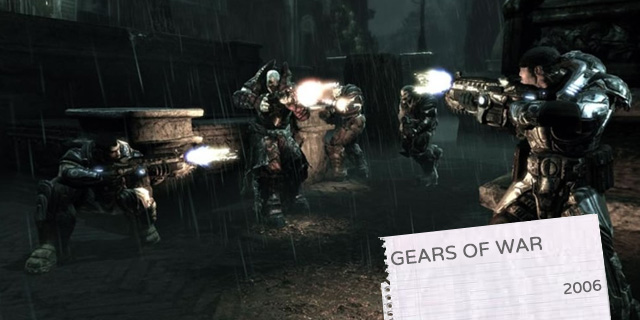

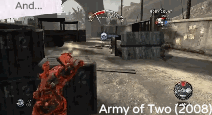

A modern firing stance
 Epic’s first Gears of War title is a hodgepodge of other, similar ideas brought together and enhanced in some remarkable ways. Sure, Kill.Switch may be the first third-person shooter to use the cover system as a central gameplay mechanic, allowing you to shoot from cover, which also introducing blind fire, Gears of War perfected it. Thanks to slower-paced gameplay and the inclusion of RE4’s offset camera, it took advantage of a brilliant concept even more effectively, essentially creating what we consider the modern third-person shooter.
Epic’s first Gears of War title is a hodgepodge of other, similar ideas brought together and enhanced in some remarkable ways. Sure, Kill.Switch may be the first third-person shooter to use the cover system as a central gameplay mechanic, allowing you to shoot from cover, which also introducing blind fire, Gears of War perfected it. Thanks to slower-paced gameplay and the inclusion of RE4’s offset camera, it took advantage of a brilliant concept even more effectively, essentially creating what we consider the modern third-person shooter.
 For all practical purposes, Gears of War has become the default, stereotypical ideal for the mass-market third-person shooter. Since then, so many games are “Gears with a twist,” or “Gears in a different setting.” Is it a stagnation problem, or does it just make sense to build off a solid base?
For all practical purposes, Gears of War has become the default, stereotypical ideal for the mass-market third-person shooter. Since then, so many games are “Gears with a twist,” or “Gears in a different setting.” Is it a stagnation problem, or does it just make sense to build off a solid base?
 It absolutely makes sense to build off of Gears of War’s immense success and its mastery of those base mechanics, but I also think stagnation is a huge issue with the genre. Look at how quickly Gears of War went from the top of its class with the first three games to completely forgettable with the release of Judgment in a matter of a couple of years. Having said that, its release was such a dramatic shift in focus for the genre that it seemed almost inevitable.
It absolutely makes sense to build off of Gears of War’s immense success and its mastery of those base mechanics, but I also think stagnation is a huge issue with the genre. Look at how quickly Gears of War went from the top of its class with the first three games to completely forgettable with the release of Judgment in a matter of a couple of years. Having said that, its release was such a dramatic shift in focus for the genre that it seemed almost inevitable.
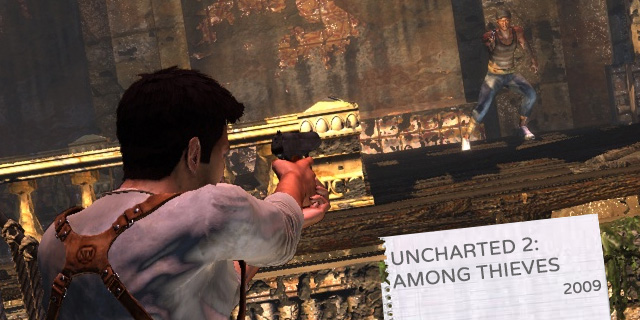



New ways to explore
 Uncharted 2 isn’t the most original game ever created, but that doesn’t mean it isn’t influential. It took concepts from series like Tomb Raider, as well as the original Uncharted, and evolved them, basically becoming the first Hollywood blockbuster in game form. Its cinematic approach to action became highly influential, not just in third-person shooters, but all action games. It is the modern third-person shooter in its truest form.
Uncharted 2 isn’t the most original game ever created, but that doesn’t mean it isn’t influential. It took concepts from series like Tomb Raider, as well as the original Uncharted, and evolved them, basically becoming the first Hollywood blockbuster in game form. Its cinematic approach to action became highly influential, not just in third-person shooters, but all action games. It is the modern third-person shooter in its truest form.
 I brought up earlier how the genre’s perfect for recreating movie-style experiences. Uncharted 2 was possibly one-upping them, making an interactive action film that’s better than most action films. So it makes sense that Uncharted and games like it are going back in the other direction and becoming films.
I brought up earlier how the genre’s perfect for recreating movie-style experiences. Uncharted 2 was possibly one-upping them, making an interactive action film that’s better than most action films. So it makes sense that Uncharted and games like it are going back in the other direction and becoming films.
 It has become a fairly common trend these days all thanks to games like Uncharted 2, but it doesn’t take away from its gameplay, specifically how varied it is in comparison to the Gears of Wars of the world. The fact that it took heavy inspiration from the original Tomb Raider series and then eventually inspired that series’ 2013 reboot speaks volumes to its success on the genre (and perhaps the medium as a whole).
It has become a fairly common trend these days all thanks to games like Uncharted 2, but it doesn’t take away from its gameplay, specifically how varied it is in comparison to the Gears of Wars of the world. The fact that it took heavy inspiration from the original Tomb Raider series and then eventually inspired that series’ 2013 reboot speaks volumes to its success on the genre (and perhaps the medium as a whole).
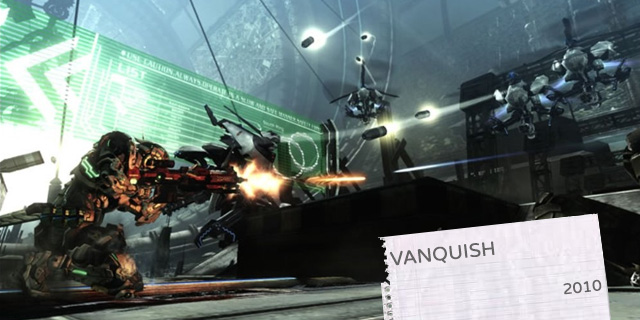



Always on the move
 While most third-person shooters stuck with a pretty specific formula following the success of Gears of War, Vanquish became the first of its kind to really take the concept of mobility in a whole new direction. It introduced a speedy slide ability that allowed for faster movement from cover to cover, which has been seen in many third-person (and even first-person) shooters since. It also focused heavily on arcade-style action that feels straight out of a game like Space Harrier. It is both a callback to a bygone era and also a game that expanded on the speed and mobility in third-person shooters, moving away from the slow, deliberate pace of Gears of War and other, similar games.
While most third-person shooters stuck with a pretty specific formula following the success of Gears of War, Vanquish became the first of its kind to really take the concept of mobility in a whole new direction. It introduced a speedy slide ability that allowed for faster movement from cover to cover, which has been seen in many third-person (and even first-person) shooters since. It also focused heavily on arcade-style action that feels straight out of a game like Space Harrier. It is both a callback to a bygone era and also a game that expanded on the speed and mobility in third-person shooters, moving away from the slow, deliberate pace of Gears of War and other, similar games.
 Anyone reading this will notice that the history of the third-person shooter is a heavily-Western one, but that doesn’t mean that its Japanese roots have disappeared. Occasional games, like Vanquish, show that the genre has some real versatility.
Anyone reading this will notice that the history of the third-person shooter is a heavily-Western one, but that doesn’t mean that its Japanese roots have disappeared. Occasional games, like Vanquish, show that the genre has some real versatility.
 Very true. While Western developers were heading in very specific directions with Gears of War and Uncharted, Shinji Mikami and the team at Platinum Games decided to demonstrate their take on the modern third-person shooter by making it distinctly Japanese in both tone and gameplay. Sure, the influences are still there, but Vanquish goes so out of its way to become so much of its own thing that it’s difficult to make substantial comparisons between it and its predecessors.
Very true. While Western developers were heading in very specific directions with Gears of War and Uncharted, Shinji Mikami and the team at Platinum Games decided to demonstrate their take on the modern third-person shooter by making it distinctly Japanese in both tone and gameplay. Sure, the influences are still there, but Vanquish goes so out of its way to become so much of its own thing that it’s difficult to make substantial comparisons between it and its predecessors.
GIFs by Christian Stewart.



















